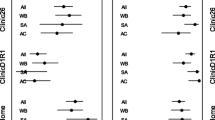Abstract
Blood pressure (BP) was assessed by patients themselves in recently published trials. Self-measured office blood pressure (SMOBP) seems particularly interesting for limited health resources regions. The aim of our study was to evaluate the relationship between SMOBP values and those estimated by ambulatory blood pressure monitoring (ABPM). Six hundred seventy-seven patients were evaluated using both, SMOBP and ABPM. The differences between SMOBP and daytime ABPM were evaluated with paired “t” test. The correlations among SMOBP and ABPM were estimated using Pearson’s r. The accuracy of SMOBP to identify abnormal ABPM was determined using area under ROC curve (AUC). Sensitivity, specificity, and positive and negative predictive values were calculated for different SMOBP cut-points. Using the average of three readings, systolic SMOBP was higher (3.7 (14.2) mmHg, p < 0.001) and diastolic SMOBP lower (1.5 (8.1) mmHg, p < 0.001) than ABPM. Both BP estimates had a significant correlation, r = 0.67 and r = 0.75 (p < 0.01) for systolic and diastolic BP, respectively. Systolic SMOBP predicted systolic abnormal ABPM; the AUC were 0.80 (0.77–0.84) and 0.78 (0.74–0.81) for daytime and 24 h hypertension, respectively. Diastolic SMOBP predicted diastolic hypertension, AUC 0.86 (0.83–0.88) for both daytime and 24 h hypertension. Neither correlations nor AUCs improved significantly using the average of five readings. SMOBP ≥ 160/90 mmHg was highly specific (>95%) to identify individuals with hypertension in the ABPM; SMOBP < 130/80 mmHg reasonably discarded abnormal ABPM. In conclusion, a high proportion of individuals could be classified adequately using SMOBP, reducing the necessity of healthcare resources and supporting its utility for screening purposes.



Similar content being viewed by others
References
SPRINT Research Group, Wright JT Jr, Williamson JD, Whelton PK, Snyder JK, Sink KM, Rocco MV, et al. A randomized trial of intensive versus standard blood-pressure control. N Engl J Med. 2015;373:2103–16.
SPRINT Protocol, Ambrosius WT, Sink KM, Foy CG, Berlowitz DR, Cheung AK, Cushman WC, et al. The design and rationale of a multicenter clinical trial comparing two strategies for control of systolic blood pressure: The Systolic Blood Pressure Intervention Trial (SPRINT). Clin Trials. 2014;11:532–46.
Cushman WC, Evans GW, Rodriguez CJ, Ringer RJ, Wright JT, Whelton PK, et al. Blood pressure intervention and control in the systolic blood pressure intervention trial (SPRINT). J Am Soc Hypertens. 2016;10:e4.
Kjeldsen SE, Lund-Johansen P, Nilsson PM, Mancia G. Unattended blood pressure measurements in the Systolic Blood Pressure Intervention trial: implications for entry and achieved blood pressure values compared with other trials. Hypertension. 2016;67:808–12.
Myers MG, Valdivieso M, Kiss A. Use of automated office blood pressure measurement to reduce the white coat response. J Hypertens. 2009;27:280–6.
Myers MG, Valdivieso M, Chessman M, Kiss A. Can sphygmomanometers designed for self-measurement of blood pressure in the home be used in office practice? Blood Press Monit. 2010;15:300–4.
Díaz A, Ferrante D. Trends in prevalence of hypertension in Argentina in the last 25 years: a systematic review of observational studies. Rev Panam Salud Publica. 2015;38:496–503.
Myers MG, Godwin M. Automated office blood pressure. Can J Cardiol. 2012;28:341–6.
Drawz PE, Pajewski NM, Bates JT, Bello NA, Cushman WC, Dwyer JP, et al. Effect of intensive versus standard clinic-based hypertension management on ambulatory blood pressure—results from the SPRINT (Systolic Blood Pressure Intervention Trial) ambulatory blood pressure study. Hypertension. 2017;69:42–50.
Myers MG, Godwin M, Dawes M, Kiss A, Tobe SW, Grant FC, et al. Conventional versus automated measurement of blood pressure in primary care patients with systolic hypertension: randomised parallel design controlled trial. BMJ. 2011;342:d286.
Andalib A, Akhtari S, Rigal R, Curnew G, Leclerc JM, Vaillancourt M, et al. Determinants of masked hypertension in hypertensive patients treated in a primary care setting. Intern Med J. 2012;42:260–6.
Lindbaek M, Sandvik E, Liodden K, Mjell J, Ravnsborg-Gjertsen K. Predictors for the white coat effect in general practice patients with suspected and treated hypertension. Br J Gen Pract. 2003;53:790–3.
Beckett L, Godwin M. The BpTRU automatic blood pressure monitor compared to 24 h ambulatory blood pressure monitoring in the assessment of blood pressure in patients with hypertension. BMC Cardiovasc Disord. 2005;5:18.
Verdecchia P, Porcellati C, Schillaci G, Borgioni C, Ciucci A, Battistelli M, et al. Ambulatory blood pressure. An independent predictor of prognosis in essential hypertension. Hypertension. 1994;24:793–801.
Godwin M, Birtwhistle R, Delva D, Lam M, Casson I, MacDonald S, Seguin R. Manual and automated office measurements in relation to awake ambulatory blood pressure monitoring. Fam Pract. 2011;28:110–7.
Kallioinen N, Hill A, Horswill MS, Ward HE, Watson MO. Sources of inaccuracy in the measurement of adult patients’ resting blood pressure in clinical settings: a systematic review. J Hypertens. 2017;35:421–41.
Lawes CM, Vander Hoorn S, Law MR, Elliott P, MacMahon S, Rodgers A. Blood pressure and the global burden of disease 2000. Part II: estimates of attributable burden. J Hypertens. 2006;24:423–30.
Acknowledgements
The authors would like to thank María Luz Salazar Landea for the final english corrections.
Author information
Authors and Affiliations
Corresponding author
Ethics declarations
Conflict of interest
The authors declare that they have no conflict of interest.
Rights and permissions
About this article
Cite this article
Salazar, M.R., Espeche, W.G., Stavile, R.N. et al. Could self-measured office blood pressure be a hypertension screening tool for limited-resources settings?. J Hum Hypertens 32, 415–422 (2018). https://doi.org/10.1038/s41371-018-0057-y
Received:
Revised:
Accepted:
Published:
Issue Date:
DOI: https://doi.org/10.1038/s41371-018-0057-y
- Springer Nature Limited
This article is cited by
-
Implementing Home Blood Pressure Monitoring into Clinical Practice
Current Hypertension Reports (2019)




